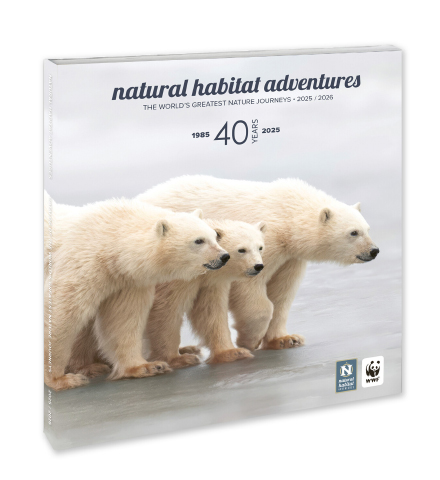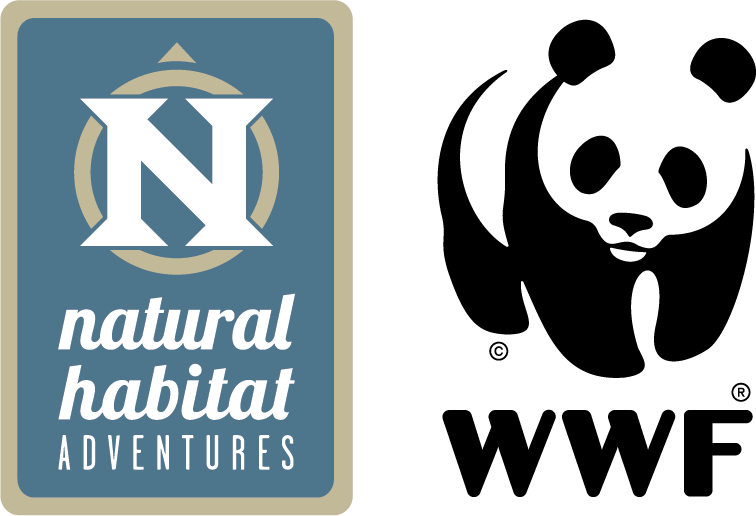We’re often asked, “When is the best time of year for a Botswana safari?”
The answer to the question is not as simple as you might think. The best time for your Botswana safari is different for landscape photographers, birders, visiting the Kalahari for the zebra migration, and if you’re embarking on a safari with kids.
Each season has pros and cons, whether you’re planning a family safari or a luxury northern Botswana expedition.
Most people will tell you that game viewing in Botswana is best in the North American summer months, which are the coolest, driest time of year, but off-peak safaris offer amazing sights and experiences, too.

Photographed by Nat Hab Staff © Nick Grossman
As I write this, we’re at the end of another shoulder season for Botswana safaris, and I’ve missed it again.
A shoulder season Botswana safari has been on my bucket list for years—ever since I returned home from my first adventure across the Okavango Delta, watched elephants frolic in the Chobe River and camped in the Moremi Game Reserve, I’ve yearned to return for a shoulder season safari. (After writing this article, a Green Season Kalahari zebra migration adventure is on my list, too.)
There are many reasons you might prefer an off-peak shoulder-season safari or a green season African adventure to a high or peak season Botswana safari. Nat Hab offers safaris in Botswana year round.
Here are some things to consider as you choose the best time of year for your Botswana safari:
Botswana Safari Peak, Low and Shoulder Seasons
There’s a little variation depending on who you ask, but Botswana’s safari seasons break down generally like this:
High or Peak Season for Botswana Safaris
The North American summer—late June through at least August—is typically considered the peak season for Botswana safaris. Some sources will extend this from June into October.
Green or Low Season for Botswana Safaris
These correspond with the rains. Late November through Botswana’s summer months of December through March and into April constitute the low or Green Season for Botswana safaris.
Shoulder Season Botswana Safari
That leaves late April, the month of May, early June and most of November (until the rains start) for shoulder season Botswana safaris.

Nat Hab Expedition Leader © Ona Basimane
Peak Season Safari in Botswana
The high season for Botswana safaris is when the weather is drier, and wildlife viewing is at its best, especially in the Okavango Delta, Moremi Game Reserve and Chobe National Park. Many experts regard the cooler months as the best time of year for a luxury safari in Botswana; they’ll say it’s the perfect weather for game drives, and the risk of malaria is at its lowest.

© David Luck
The dry season is characterized by clear skies. This can result in superb sunsets and excellent conditions for stargazing.
This is the high season for Botswana safaris because of peak wildlife viewing opportunities. At this time of year, the foliage is thinner, making animals easier to spot and wildlife is concentrated near water sources.
Early morning and evening drives can be cool. It’s a good idea to bring a warm layer of clothing for these times.
It’s important to know that temperatures reach their highest in Botswana in October. Other factors to consider during peak season for Botswana safaris are that people congregate to see animals at shrinking waterholes and that prices are at their highest.

© David Luck
Green Season Safari in Botswana
The low season for safaris in Botswana corresponds with the rains, usually from the end of November until just into April. That’s when the bulk of the year’s rain falls in Botswana.
In general, Botswana’s wildlife tends to disperse during the rainy Southern Hemisphere summer months, but not in Chobe’s Savuti region and the Kalahari! Both offer excellent summer game viewing, as they lie on the path of remarkable migrations, especially zebra.

This period is known as the Green Season, and while wildlife is easier to spot in the dry season, you can still see plenty of animals. In fact, in the Kalahari ecosystem, game viewing may even be more productive during the rainy season from December through March, when the game both migrates through the area and concentrates on the open plains and around pans.
The green summer months are also considered the best season for birding in Botswana as migrating avian species arrive. Botswana does not have any endemic avian species, but it is considered one of Africa’s top birding areas because of its protection of a number of threatened and endangered species.
In February, heavy rains transform the landscape into a lush, green paradise, especially in the Central Kalahari Game Reserve. Summer marks breeding season for the local antelope population; you might spot newborns taking their first steps. This also means more predators in the area!

African Jacana, Chobe National Park
In March, the temperature drops and rainfall can be steady. March is renowned in Botswana for its landscape photography because of the vibrant green terrain that is fed by heavy rains.
During these summer months in Botswana, some lodges and camps close, but during the green season, the Botswana safari can offer an experience of prolific, active wildlife with new life emerging and far fewer visitors.
With World Wildlife Fund, Nat Hab has designed Botswana: Kalahari, the Delta & Beyond photo and classic itineraries that include a diverse array of habitats and settings for the best range of wildlife viewing—including Africa’s second-largest migration of zebra and wildebeest!

Nat Hab guests experience the magic of the Okavango Delta on poled mokoro rides in traditional dugout canoes © Kerry de Bruyn
Witness Northern Botswana’s Incredible Zebra Migration
The green season is the very best time to see the Kalahari and arguably the Pans, too. Grazing land is covered with shoots, and greenery is plentiful. If witnessing the world’s second-largest migration is on your list, this is the time for you.
The annual zebra migration across northern Botswana starts with the rains at the end of November and is the longest and one of the most stunning migrations on the continent, stretching 311 miles from the Chobe River floodplains to the grassy plains of the Nxai Pan and back again.
This zebra migration was first noted by scientists as recently as 2014. “The distance covered by these zebras was a total shock to all of us involved in the study, as well as to people familiar with wildlife conservation in the region,” said Robin Naidoo, senior conservation scientist at World Wildlife Fund. “Nobody knew that something of this scale, with this much ground covered, was occurring.”

Zebra migration, Makgadikgadi Pans National Park
Magical Shoulder Season Safaris in Botswana
November, as well as late April, May and early June, are the shoulder seasons for Botswana safaris. November is still hot if that’s your preference and marks the start of the rainy season, but it shouldn’t affect game viewing too much.
The start of the migration is dependent on rains; zebras follow grasses from the moist floodplains of the Chobe River, passing villages on the outskirts of the Chobe Enclave as they make their way to desert through marsh and plains to dry, mopane woodlands and finally across a large stretch of the deep Kalahari Sandveld dotted with waterholes. If following this route just as the driest season ends and the rains come sounds great to you, then November is the time for you.

For me, the late April to mid-June shoulder season might be an ideal time to embark on a Botswana safari (but I also want to see the zebra migration and Green Season birds).
By April the heavy rainfall has almost completely stopped, but the landscape is still lush and verdant. The nights start to get cooler, which makes for perfect weather for evenings around the campfire and comfortable sleeping temperatures.
By mid-month, the water levels in the Okavango Delta will begin to rise; it will be a few months before that happens in Moremi. April marks the beginning of impala breeding season when the males start to compete for the attention of the females. Grasses are tall, and photo backdrops can be filled with vibrant colors.
The Kgalagadi and Central Kalahari are at their best in April, with cooler weather, abundant game and thick, green landscapes. The game is still plentiful at Nxai Pan.
May is the start of the dry winter season. This month offers excellent game viewing, mild, dry weather, and campsites and safari parks that are not too busy—as this is before peak season later in the year. Wildlife sightings are at their best in the Savuti region, where buffalo and zebra can be found in large numbers, while the elephant herds return to the Linyati Chobe River System in May.
You might spot interesting wildlife behaviors this time of year. As the dry season starts, predator-prey interactions become more frequent. Last April, a bachelor herd of elephants took up residency in Nat Hab’s Gomoti Camp as the natal herd continued its journey. Guests could watch them from the camp all day. As the floodwaters arrive and ease the tension in the smaller waterholes, the hippos at Gomoti Plains are noticeably moving around more.

Nat Hab’s Gomoti Camp—Okavango South © Andrew Morgan
On Nat Hab’s Secluded Botswana April–November itineraries, Nat Hab’s Linyanti Camp offers fantastic opportunities for watching elephants right from camp in Botswana’s pristine Linyanti Wildlife Reserve. You can also enjoy a silent, emission-free safari experience in Nat Hab’s Electric Safari Vehicle. This innovative, eco-friendly option operates out of Nat Hab’s Gomoti Camp and provides a closer look at wildlife without disturbing their natural behavior.
In May, visitors to Nat Hab’s Linyati and Gomoti camps in Botswana can expect to see a variety of wildlife. Resident elephants have been moving through the camp to snack on the nutritious camel thorns. Leopards are known to make kills and hoist their prey up into trees for safekeeping. One such incident involved a leopard hoisting an impala, much to the frustration of the hyenas below.
We can’t make promises, but wild dogs are regularly seen around the camps and are known for their exciting chases.
June closes out Botswana’s Safari Shoulder Season
The climate is exquisite in June for outdoor activities in Botswana; evenings tend to get cold, and certain areas in the Kalahari can drop below freezing after dark. Morning game drives can be chilly, so arrive prepared with some warm safari gear.
In June, Botswana is entering its dry season, which is generally considered the best time for viewing wildlife. Animals begin to congregate in large numbers along the fringes of the Okavango Delta and on the northern waterways of the Savuti Channel and Chobe Linyanti River System.
June is also a great time to see African wild dogs as they begin to search for dens for their pups.

© Kerry de Bruyn
When is the best time for a Botswana safari?
In the end, the question isn’t, “When is the best time for a safari in Botswana?” but, “When is the right time for you or for your best safari in Botswana?”
The right answer depends on your needs and desires. Do you want to see the zebra migration, photograph lush green landscapes or catalog migrating birds as they make their way across the northern Botswana landscape? Then, a Green Season Botswana safari may be just the thing for you.
Do you relish the idea of cool June evenings and mornings on safari, watching wildlife as they adapt to increasingly dry conditions? Do you love taking your holiday time just before kids around the world are out of school on vacation? Then, a late May or early June Botswana safari may be just the right time for you.
If you aim for peak wildlife viewing—including a bit of wild time with your kids or grandkids—then perhaps a peak season or family Botswana safari is exactly what you are looking for.

© Laurie Collins


























